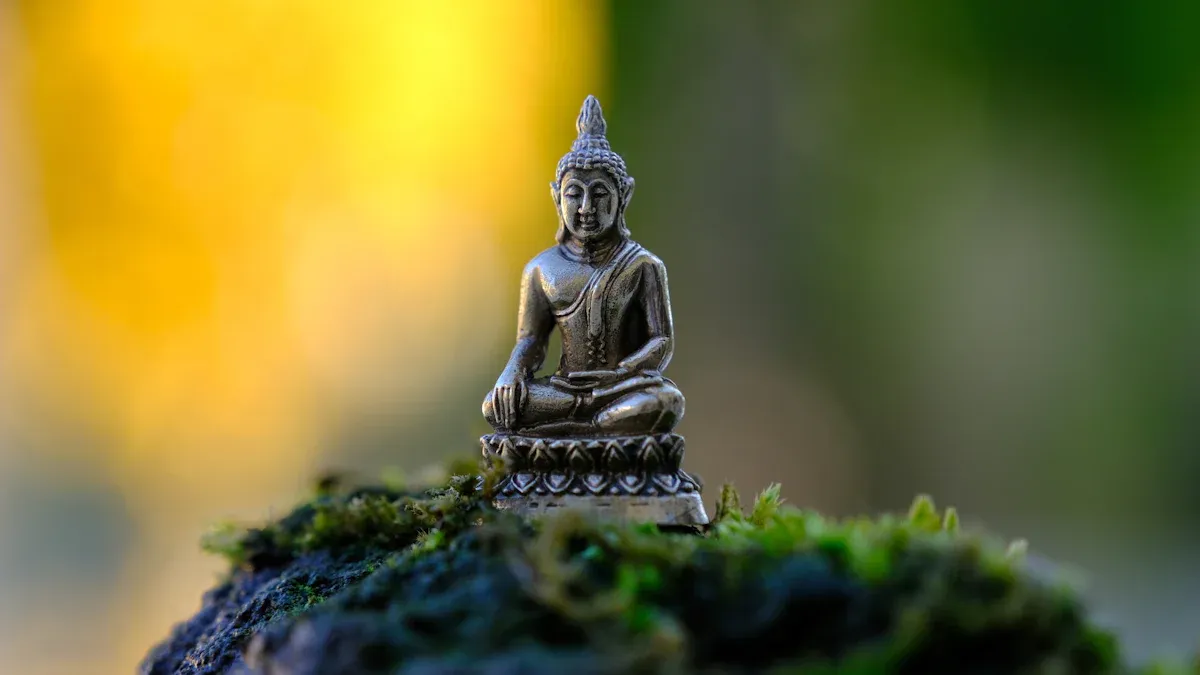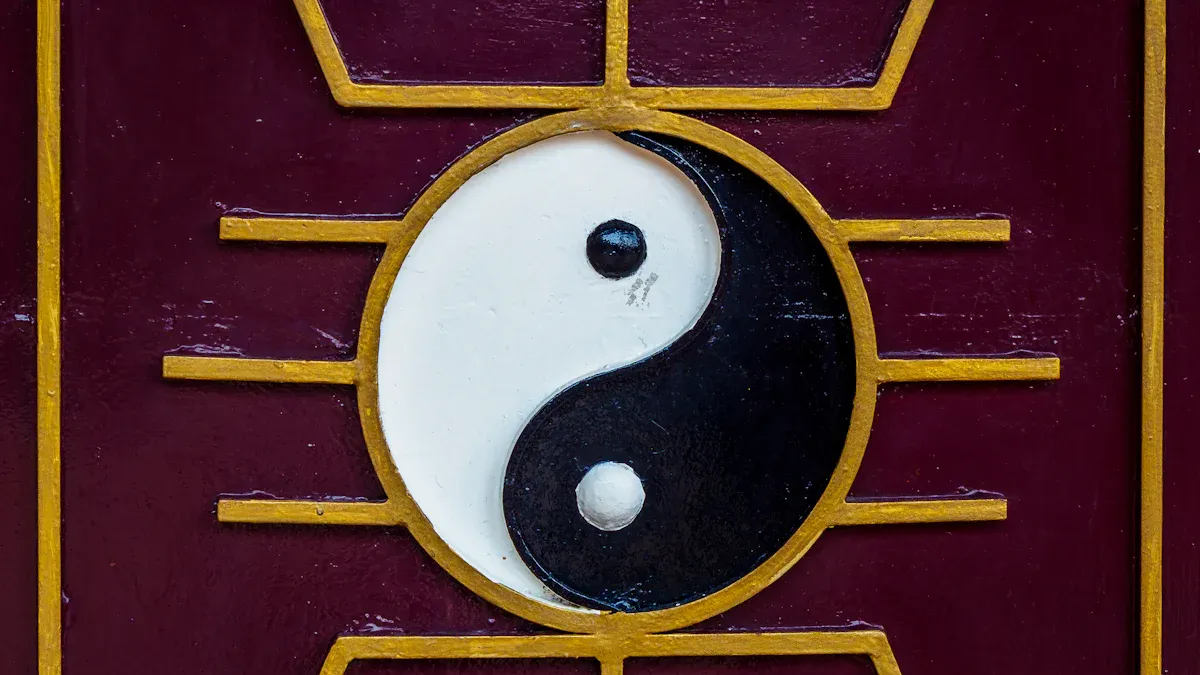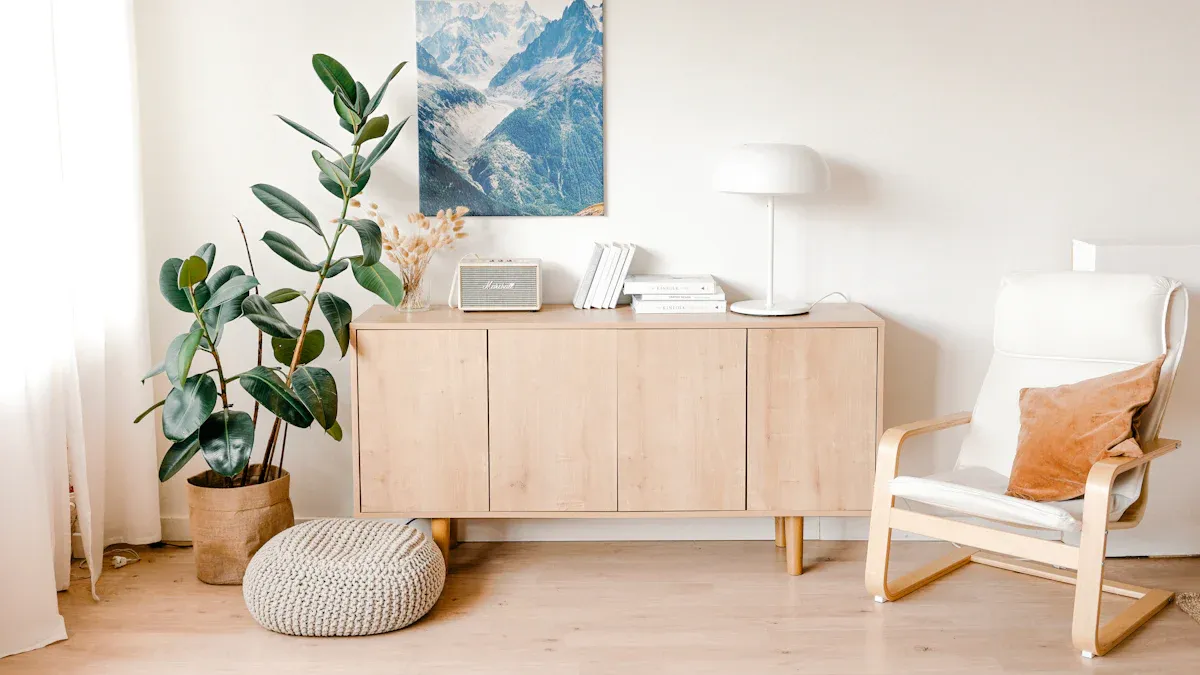
Feng shui means "wind and water." It helps you set up your space for harmony and happiness by following the principles of feng shui. These principles teach you to balance energy, elements, and space, which helps you feel better. Many people know these principles, especially in Chinese-American communities. Feng shui is now popular all over the world, and people use the principles of feng shui to improve their lives. You do not need to change everything; small changes based on the principles of feng shui can help your home feel peaceful and balanced.
Key Takeaways
Feng Shui helps balance energy in your home to create peace and happiness with small, simple changes.
Qi is life energy that should flow smoothly; keep spaces clean and open to help Qi move well.
Use the Five Elements—Wood, Fire, Earth, Metal, and Water—to add balance and support your goals.
Mix Yin (calm) and Yang (active) energies in each room to make spaces feel comfortable and lively.
The Bagua Map divides your home into areas linked to life goals; use it to place colors and items that boost energy.
What Is Feng Shui?

Origins and Meaning
Feng Shui means "wind and water." You can trace its roots back to ancient China, about 6,000 years ago. People first used Feng Shui to decide where to build homes, farms, and burial sites. They wanted to find places where the wind would not blow too harshly and water would bring life. This practice helped families stay safe and healthy. Over time, Feng Shui became a tradition passed down by scholars. You can see its influence in the way cities, temples, and homes were designed. The main goal was to create spaces that support the natural flow of Qi, the life force energy. Qi moves through everything, and the principles of Feng Shui help you guide this flow for better living. The idea of harmony with nature stands at the heart of Feng Shui. You learn to look at mountains, rivers, and even the layout of your room to find the best way for Qi to move.
Purpose and Benefits
The purpose of Feng Shui is to help you live in balance with your surroundings. When you use the principles of Feng Shui, you focus on the flow of Qi in your space. You want to make sure Qi moves smoothly, without getting stuck or rushing too fast. This balance brings harmony with nature and supports your well-being. Feng Shui analysis uses ideas from Taoism, such as Yin and Yang, the Five Elements, and the Bagua map. These tools help you understand how energy flows and how you can improve it. Many people say that practicing Feng Shui makes their homes feel calm, safe, and welcoming. You may notice more comfort, peace, and support in your daily life. Some people also report better relationships and more luck. While scientists have not found proof that Feng Shui changes health or happiness, you can still enjoy the beauty and order it brings. When you try Feng Shui analysis, you take steps to create a space that feels good and supports your goals.
Basic Principles of Feng Shui
Feng Shui uses main ideas to help you make your space peaceful and healthy. When you learn these basic principles, you can make choices that help good energy move in your home. Let’s look at each principle and see how you can use them every day. (Enhance the Qi flow in your space with specific crystals by reading our article on How to Use Feng Shui Crystals in Every Room of Your Home )
Chi (Energy Flow)
Qi is the life force that moves through people, things, and places. In Feng Shui, you want Qi to move gently and easily in your home. When Qi moves well, you feel safe, happy, and full of energy. If Qi gets stuck or moves too fast, it can make you feel uneasy or stressed.
Tip: You can help Qi flow by keeping walkways open, cleaning up clutter, and fixing broken things. For example, let sunlight into your living room, put sofas against strong walls, and turn chairs to face each other. This helps Qi move and makes it easier to talk and relax.
Qi comes in through the front door and goes through each room. You want to stop Qi from leaving too quickly or getting stuck. Use the Bagua Map to match parts of your home with your life goals, and balance the five elements to keep Qi moving well. In your bedroom, put your bed in a strong spot to help Qi flow calmly. In the kitchen, do not put the stove and sink right across from each other so Qi does not clash. These small steps help you keep good Chi and healthy Qi in your home.
Five Elements
The five elements idea is very important in Feng Shui. Each element—Wood, Fire, Earth, Metal, and Water—has its own qualities and helps Qi move in special ways. You can use these elements to make your home balanced and peaceful. (Learn more about each element's influence in Feng Shui in our detailed guide on What Are the Five Elements in Feng Shui and What Do They Mean)
Element |
Characteristics |
Symbolic Meaning |
Associated Colors |
Shapes |
|---|---|---|---|---|
Wood |
Growing, lively, flexible |
Growth and creativity |
Greens, Blues, Teals |
Tall shapes |
Fire |
Warm, changing, strong |
Energy and passion |
Reds, Oranges |
Pointed shapes |
Earth |
Steady, caring, solid |
Support and stability |
Browns, Tans, Yellows |
Square shapes |
Metal |
Hard, exact, cool |
Strength and order |
White, Gray, Blue |
Round shapes |
Water |
Deep, flowing, wise |
Clarity and wisdom |
Black, Dark Gray, Blue |
Wavy shapes |
You can add the five elements to your space in easy ways:
Put wooden chairs or plants for Wood.
Use candles or warm lamps for Fire.
Place rocks or clay pots for Earth.
Add metal frames or shiny mirrors for Metal.
Set up a small water fountain or use blue things for Water.
Note: Try to keep all elements balanced. Do not let one element take over. Use the Bagua Map to put elements where they help your goals and keep Qi healthy.
Yin and Yang
Yin and Yang show how opposite energies work together. Yin is soft, quiet, and calm. Yang is bright, busy, and lively. You need both to make a room feel good and balanced. In Feng Shui, you try to mix Yin and Yang in every space.
For bedrooms, use more Yin. Pick cool, dark colors, soft blankets, and dim lights to make it restful. Do not put workout gear in bedrooms because it brings too much Yang. Add small warm-colored items to keep things balanced.
Living rooms need more Yang. Use bright colors, open areas, and fun things like a TV. Add soft chairs and gentle pictures to bring in Yin. Keep both rooms tidy to help Qi move well. (Explore how Taoist principles, including Yin and Yang, enhance urban living in Taoism and the Art of Urban Slow Living )
Tip: Use lights you can dim to change Yin and Yang as needed. Cut bushes outside to let in more light and bring in good Qi.
Bagua Map
The Bagua Map helps you see how Qi moves in your home. It splits your space into nine parts, each linked to a part of life like health or money.
To use the Bagua Map:
Get a map of your home.
Find the main door.
Match the Bagua Map to your home map, using the door as a guide.
See which part matches each life area.
Add colors, elements, or signs to help Qi in each part.
Check and change things often to keep Qi moving well.
Here are the main Bagua Map areas and what they mean:
Bagua Area |
Life Aspect |
Element |
Colors |
|---|---|---|---|
North |
Career, new starts, life path |
Water |
Blue, Black |
Northeast |
Wisdom, learning, school |
Earth |
Beige, Light Yellow |
East |
Family and health |
Wood |
Brown, Green |
Southeast |
Money and plenty |
Wood |
Brown, Green |
South |
Fame and praise |
Fire |
Red, Yellow, Orange, Pink, Purple |
Southwest |
Love, marriage, friends |
Earth |
Beige, Light Yellow |
West |
Kids and projects |
Metal |
White, Gray |
Northwest |
Helpful people, travel |
Metal |
White, Gray |
Center |
Health, balance |
Earth |
Yellow, Brown |

You can use the Bagua Map to find which part of your home needs help. If you want to do better at work, focus on the North part and add Water things or blue colors to help Qi. (Optimize your bedroom layout using Feng Shui principles by reading How to Arrange Your Bed for the Best Feng Shui Results)
Commanding Position
The commanding position is a spot in a room where you feel safe and strong. You can see the door, but you are not right in front of it. Your back should be against a solid wall. This helps you feel protected and lets Qi come to you gently.
In your bedroom, put your bed so you can see the door but not face it straight. Put the headboard against a strong wall. Do not put the bed under a window or right across from the door. In your office, put your desk so you can see the door, with your back to a wall. This helps you focus, feel sure, and keeps Qi moving well.
Note: The commanding position puts your furniture in the safest part of the room. It helps you get good energy and supports your health.
By using these main ideas, you can use Feng Shui to make your space balanced, friendly, and full of life. Even small changes can help Qi move well and support your dreams.
Feng Shui Design Principles in Practice

Decluttering and Organization
You can make your home better by cleaning up clutter. When you remove clutter, Qi can move more easily. This makes your home feel calm. Studies say a clean space lowers stress and helps you feel happy. People with neat homes often feel less stressed and healthier. Here are some ways to declutter:
Put things in three groups: keep, throw away, or give away.
Get rid of things you have not used in a year.
Clean out closets and under beds to clear stuck energy.
Give away nine things to welcome new chances.
Make sure everything has a place to stop messes.
Open windows and doors to let fresh energy in.
Tip: Begin with a small spot. Work on one area at a time so you do not get stressed.
Cleaning up clutter can help you get along better with others. It also helps you feel good about your home. You may sleep better and find it easier to cook healthy food.
Furniture Placement
Where you put furniture is important in feng shui. Put furniture so you can walk easily and Qi can move well. Place big items like beds or sofas in the commanding position. This means you can see the door but are not right in front of it. Use pairs, like two nightstands, to make the room feel balanced.
Guideline |
How to Apply in Your Home |
|---|---|
Allow free energy flow |
Keep paths clear and do not block windows. |
Commanding position |
Put beds and desks to face the door, not straight. |
Balance and harmony |
Use pairs for a peaceful feeling. |
Use natural light |
Move furniture to let sunlight in. |
Do: Add plants and mirrors to clean air and bounce light.
Don’t: Put big furniture in front of doors or windows.
Colors and Elements
Colors change how you feel in a room. Each color matches one of the five elements. You can pick colors to help each room do its job.
Element |
Colors |
Room Use |
|---|---|---|
Wood |
Green, Brown, Blue |
Bedrooms, living rooms |
Fire |
Red, Orange |
Fame areas, accents |
Earth |
Yellow, Beige, Light Brown |
Kitchens, health areas |
Metal |
White, Gray, Metallic |
Offices, creative spaces |
Water |
Black, Navy, Deep Blue |
Entryways, career areas |
Blue and black help you stay calm and focus. Green helps things grow. Red gives you energy. Yellow makes you feel happy. White and gray help you think clearly. Use these colors to get the feeling you want in each room.
Creating Balance
Balance matters when you use feng shui at home. Use the Bagua Map to work on parts of life you want to change. Mix all five elements in every room for peace. Let in sunlight and fresh air to keep Qi moving. Put beds and sofas so you can see the door but not face it. Arrange seats in a circle in the living room to help people talk.
Try the 3-5-7 rule for decorating. Put things in groups of three, five, or seven to make the room look nice and feel good. For example, put three candles on a table or five pillows on a couch.
Ways to help Qi move better are cleaning up, letting in sunlight, and moving furniture for open paths. Even small changes can make your home feel happy and full of energy.
Feng shui helps you balance Qi, use the five elements, and create harmony in your home. Simple changes like decluttering or moving furniture can make your space feel calm and happy.
You may notice less stress and better sleep.
Organizing your room helps you focus and feel in control.
You can start with small steps. Every change brings you closer to a peaceful and healthy home. Explore feng shui and see how it improves your life.
FAQ
What is Qi in Feng Shui?
Qi means life force energy. You want Qi to move gently through your home. Good Qi helps you feel healthy and happy. You can improve Qi by cleaning, letting in sunlight, and arranging furniture for open paths.
How do I use the Bagua Map?
You match the Bagua Map to your home's layout. Start at your front door. Divide your space into nine areas. Each area connects to a part of your life. Add colors or elements to boost Qi in each zone.
Can I practice Feng Shui without changing everything?
Yes! You can start with small steps. Declutter one room. Move your bed to a commanding position. Add plants or natural light. Even simple changes help Qi flow and make your home feel peaceful.
Which colors work best for Feng Shui?
Element |
Color Example |
Room Suggestion |
|---|---|---|
Wood |
Green |
Bedroom |
Fire |
Red |
Living Room |
Earth |
Yellow |
Kitchen |
Metal |
White |
Office |
Water |
Blue |
Entryway |
Choose colors based on the element you want to balance.
Does Feng Shui follow Taoism?
Yes. Feng Shui uses ideas from Taoism, like Yin and Yang, the Five Elements, and Wu Wei. The Tao Te Ching inspires many Feng Shui principles. You learn to create harmony with nature and energy in your space.
See Also
How to Use Feng Shui Crystals in Every Room of Your Home
What Are the Five Elements in Feng Shui and What Do They Mean






